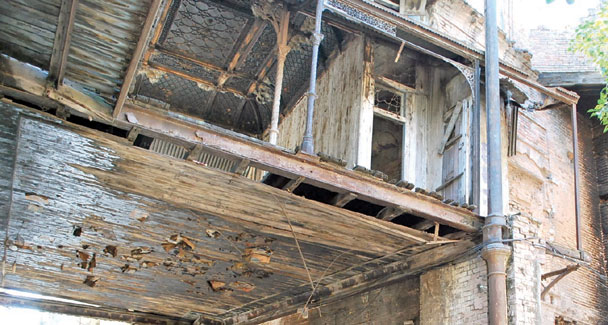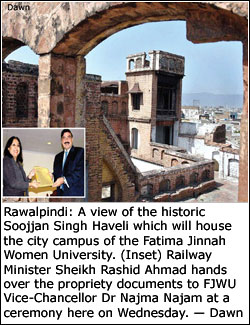Rai Bahadur Soojan Singh, Haveli
Rai Bahadur Soojan Singh, was a wealty merchant and bussiness man of Rawalpindi who had a flourishing timber business. Located in the Punjab province, 275 km (171 miles) north-west of Lahore the city (now in Pakistan) served as Pakistan's capital while Islamabad was being constructed.
Rai Bahadur Soojan Singh was an eminent personality of his day. He had a royal taste and temperament. The haveli that he built was a virtual palace with a majestic throne made of gold and bedrooms furnished with ivory furniture. In the courtyards peacocks danced and a tiger strolled through the corridors. Live music filled the evenings. The haveli had its own water supply system with a well connected to 30 lines.
The house was built in two parts with a bridge connecting them on the fourth floor. The iron used in the pillars and embellishments of the doorways was imported from UK. It was given over to the the state and served as a headquarters for Sikh Officers at one time.
Since the Partition several attempts have been made to turn the huge building into a school or government office. Once plans were announced for the Building to become Fatima Jinnah (the sister of M.A. Jinnah) Womens University, it was even offered to A.Q. Khan, the father of Pakistan's nuclear bomb, as a girls science school. The original finish has weathered away leaving the brick exposed, giving it the local appelation - The Lal Haveli (Red Mansion).
Story below by: By Jafar Abbas, Wednesday, 25 Mar, 2009, Dawn
The once majestic haveli of Rai Bahadur Soojan Singh that still stands cramped between the narrow streets of Bhabra Bazaar is crumbling for lack of proper maintenance. Built in 1893 by the Rai Bahadur as residence for his family, it also served as a kind of museum for his family pictures, antique objects, Victorian furniture, precious China and silverware etc., but now its large rooms and ante chambers lie vacant and it gives the looks of a haunted palace in ruins.
Over the years since partition of the Indian Subcontinent it has housed refugees from Kashmir until General Zia-ul-Haq had it vacated, handing it over to nuclear scientist A.Q. Khan to house a science college for girls but that project for some reasons did not see the light of the day.
Later the former Railways Minister Sheikh Rashid Ahmed decided to turn it into a campus of the Fatima Jinnah Women’s University. However this plan too could not materialise due to its present congested location in a busy commercial area. The university is now planning to start a project named School of Cultures, Heritage, Architechture and Designs for girls. This project too may die as there are no funds available for it.
Rai Bahadur Soojan Singh was an eminent personality of his day. He had a royal taste and temperament. The haveli that he built was a virtual palace with a majestic throne made of gold and bedrooms furnished with ivory furniture. In the courtyards peacocks danced and a tiger strolled through the corridors. Live music filled the evenings. The haveli had its own water supply system with a well connected to 30 lines.
Visitors marveled at the intricate woodwork on the doors and windows and the bridge that spanned the two sections of the building with balconies overlooking the courtyard. The covered area of the haveli was 24,000 sq.ft (2,230 sq. meters) spread over four stories comprising 45 rooms lit on evenings by huge lamps and chandeliers.
In place of that glittering structure there now stands a dark hulk where huge bats fly at night. All of its adornments that still remained after it had been plundered by local people, were pulled out by the refugees and sold away for pennies.


